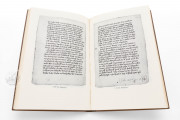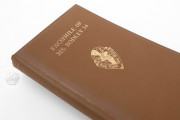Oxford's MS Bodley 34 manuscript contains a collection of religious pieces in early Middle English likely written for a woman and known as the “Katherine Group”. The small volume contains five separate works: three saint’s lives, a popular sermon on maidenhood, and an allegorical, anchoritic text. Based on linguistic study and later additions, the creation of the manuscript has been localized to Herefordshire in England in the years before 1240.
The manuscript is without a decorative program. The script is a transitional type between Protogothic and Gothic textura written by an older scribe with traditional training. In parts, the writing is rather difficult to read leading to challenges for transcription. The early life of the book is unknown, but it eventually came to be used as scratch parchment in a Herefordshire law office during which time several marginal additions were made providing a glimpse into English life in the Midlands during the Tudor period. Overall, this small book is an understated treasure of medieval literature and life.
Five Works for Women
The collection of five religious pieces, St. Katherine of Alexandria, St. Margaret of Antioch, St. Juliana of Nicomedia, Hali Meiðhad, and Sawles Warde, all suggest a female reader.
The first three works are the stories of the lives of three female saints. Saint’s lives were popular literary pieces throughout the Middle Ages, usually focused on the miracles and deeds of the saint. The sermon, Hali Meiðhad, or Holy Maidenhood, praises virginity over marriage and Sawles Warde, an allegory about the soul and body, also suppose a female reader. This points to the patron or the original intended recipient being a woman, perhaps one intending to enter monastic life.
Half-Rubricated Text
The five original texts were all written by the same scribe, who began the work somewhat calligraphically, but after the first quire the hand becomes less legible. Throughout the work, spaces for enlarged rubricated initials were left for these to be added later.
The omitted letter was then noted in the outer margin, perhaps with the intention that these be trimmed out. Several pages were completed with the planned rubricated initials and line fillers, however most of the manuscript was left incomplete. It serves as evidence for the process involved in creating these books.
Added Sixteenth-Century Legal Marginalia
The early life of the manuscript is a mystery, however a number of marginal additions were made in the fifteenth century that suggest it was used as scratch parchment for pen trials in a Herefordshire lawyer’s office. The names of several members of the local petty nobility appear allowing these scribbles to be dated to around the year 1569.
A poetic passage added around this time at the end of St. Juliana suggests the contents of the book were, at least in part, legible at the time, but that its value to the law office was material rather than textual. The book eventually entered the Bodleian library at Oxford by way of a gift of Thomas Twine in 1612.
We have 1 facsimile edition of the manuscript "St. Katherine, St. Margaret, St. Juliana, Hali Meiðhad, Sawles Warde": St. Katherine, St. Margaret, St. Juliana, Hali Meiðhad, Sawles Warde facsimile edition, published by Oxford University Press, 1960
Request Info / Price










